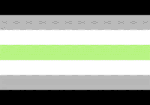LGBTQI+ Flags
In 1978 gay rights activist Gilbert Baker created the first Pride flag with the goal of it being a symbol for everyone. Since then many new flags were created to represent all communities within the LGBTQI+ community.
The Pride Flag
 The colour red represents life, orange represents healing, yellow represents sunlight, green represents nature, blue represents peace/harmony and violet represents spirit.
The colour red represents life, orange represents healing, yellow represents sunlight, green represents nature, blue represents peace/harmony and violet represents spirit.
Progress Pride Flag
 The Progress Pride Flag is the updated pride flag, which acknowledges queer people of colour with the black and brown strips. In addition, the pink, white, and blue are a representation of the transgender flag.
The Progress Pride Flag is the updated pride flag, which acknowledges queer people of colour with the black and brown strips. In addition, the pink, white, and blue are a representation of the transgender flag.
Transgender Pride Flag
 The three colours of the Transgender Pride Flag represent women and girls (pink) men and boys (blue) and white for those are intersex, transitioning or describe themselves as having an unidentified gender.
The three colours of the Transgender Pride Flag represent women and girls (pink) men and boys (blue) and white for those are intersex, transitioning or describe themselves as having an unidentified gender.
Bisexual Pride Flag
 The pink represents those who are attracted to the same gender identity, the purple for attraction to two genders and blue represents those are attracted to a different gender.
The pink represents those who are attracted to the same gender identity, the purple for attraction to two genders and blue represents those are attracted to a different gender.
Lesbian Pride flag
 The colours represent gender nonconformity (dark orange), independence (orange), community (light orange), unique connections to womanhood (white), tranquillity and peace (pink), dusty pink (love and sex), and dark rose (femininity).
The colours represent gender nonconformity (dark orange), independence (orange), community (light orange), unique connections to womanhood (white), tranquillity and peace (pink), dusty pink (love and sex), and dark rose (femininity).
Pansexual Pride flag
 The Colours represent attraction to those who identify as female (pink), the attraction to those who identify as male (blue), and attraction to those who identify as genderqueer, nonbinary, agender, androgynous, or anyone who doesn’t identify on the male-female binary (yellow).
The Colours represent attraction to those who identify as female (pink), the attraction to those who identify as male (blue), and attraction to those who identify as genderqueer, nonbinary, agender, androgynous, or anyone who doesn’t identify on the male-female binary (yellow).
Intersex Pride Flag
 The flag is containing a golden yellow field, with a purple circle emblem, to avoid gender stereotypes.
The flag is containing a golden yellow field, with a purple circle emblem, to avoid gender stereotypes.
Asexual Pride Flag
 The black represents asexuality, the grey for grey-asexuality and demisexuality, the white for non-asexual partners, and the purple for community.
The black represents asexuality, the grey for grey-asexuality and demisexuality, the white for non-asexual partners, and the purple for community.
Non-binary Pride Flag
 The colours represent people completely outside of the gender binary (yellow), people with multiple genders (white), people whose identity incorporates aspects of male and female (purple), and those who do not identify with any specific gender (black).
The colours represent people completely outside of the gender binary (yellow), people with multiple genders (white), people whose identity incorporates aspects of male and female (purple), and those who do not identify with any specific gender (black).
Agender Pride Flag
 The colours represent absence of gender (black and white), semi-genderlessness (grey), and nonbinary genders (green).
The colours represent absence of gender (black and white), semi-genderlessness (grey), and nonbinary genders (green).
Gender-Fluid Pride Flag
 The colours represent feminine (pink), absence of gender (white), the combination of masculine and feminine (purple), genders who do not share feminine or masculine traits (black), and masculine (blue).
The colours represent feminine (pink), absence of gender (white), the combination of masculine and feminine (purple), genders who do not share feminine or masculine traits (black), and masculine (blue).
Gender Queer Pride Flag
 The use of lavender is meant as a combination of pink and blue, symbolizing a mixture of male and female. On the other hand, the dark green is meant to stand for people who identify beyond the gender binary and stand as the opposite of lavender. The white signifies the absence of gender.
The use of lavender is meant as a combination of pink and blue, symbolizing a mixture of male and female. On the other hand, the dark green is meant to stand for people who identify beyond the gender binary and stand as the opposite of lavender. The white signifies the absence of gender.

